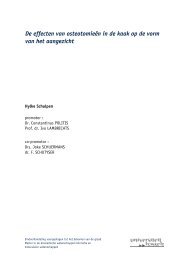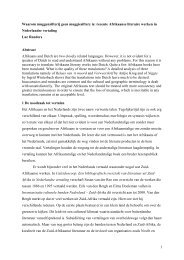Planning Problems in Intermodal Freight Transport ...
Planning Problems in Intermodal Freight Transport ...
Planning Problems in Intermodal Freight Transport ...
You also want an ePaper? Increase the reach of your titles
YUMPU automatically turns print PDFs into web optimized ePapers that Google loves.
term<strong>in</strong>al with a s<strong>in</strong>gle crane. Their objective is to determ<strong>in</strong>e quality of service <strong>in</strong> terms of<br />
wait<strong>in</strong>g times and utilisation of resources, especially with regard to the dimensions of the<br />
wait<strong>in</strong>g areas for <strong>in</strong>com<strong>in</strong>g trucks. Stochastic Petri-nets are used as modell<strong>in</strong>g language and<br />
results are obta<strong>in</strong>ed numerically by computation of the steady state distribution of an<br />
associated Markov cha<strong>in</strong>.<br />
In Kozan [37] a network model is presented to analyze conta<strong>in</strong>er progress <strong>in</strong> a multimodal<br />
conta<strong>in</strong>er term<strong>in</strong>al. As objective the author m<strong>in</strong>imizes total throughput time, which is the sum<br />
of handl<strong>in</strong>g and travell<strong>in</strong>g times of conta<strong>in</strong>ers from the time the ship arrives at the port until<br />
the time they are leav<strong>in</strong>g the term<strong>in</strong>al and <strong>in</strong> reversed order. The mathematical model can be<br />
applied as decision support tool for equipment <strong>in</strong>vestments. Long-term data collection should<br />
be carried out before implement<strong>in</strong>g the model. Simulation models are also frequently<br />
designed to support tactical decisions at an <strong>in</strong>termodal term<strong>in</strong>al. Kulick and Sawyer [38]<br />
develop a simulation model to support the analysis of labour deployment and other resource<br />
capacities at a major <strong>in</strong>termodal term<strong>in</strong>al. The model is used to explore areas where conta<strong>in</strong>er<br />
throughput can be improved. Huynh [39] proposes statistical and simulation models to expla<strong>in</strong><br />
the relationship between the availability of yard cranes and truck turn time. Truck turn time is<br />
def<strong>in</strong>ed as the time it takes a truck to complete a transaction at an <strong>in</strong>termodal term<strong>in</strong>al.<br />
A second tactical plann<strong>in</strong>g problem of term<strong>in</strong>al operators is the redesign of operational<br />
rout<strong>in</strong>es and layout structures. Voges et al. [40] analyse operat<strong>in</strong>g procedures for an exist<strong>in</strong>g<br />
term<strong>in</strong>al. Three questions are studied. How should the dispatcher at the gate and the crane<br />
drivers make their decisions on how to cont<strong>in</strong>ue the process? If a certa<strong>in</strong> crane strategy would<br />
result <strong>in</strong> favourable wait<strong>in</strong>g times for trucks, are the crane drivers able to follow it without<br />
computer support? When would it be useful to abandon the strategy and to work <strong>in</strong>tuitively?<br />
Average wait<strong>in</strong>g time of trucks serves as performance criterion. A comb<strong>in</strong>ation of Human









